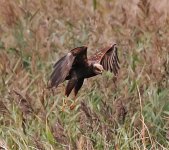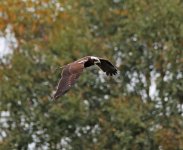Hi all.
I would realy appreciate any help from other BFers, to age and sex these two Marsh Harriers. This will help me greatly with regard to the accuracy of my 'local records'. Both birds photographed today 09/10/2009. I believe, at least, that one is M and one is F, but I could be wrong on both counts. The female ( well proposed female ) also appears to be banded on the right leg.
Here is what I think, 1st pic - 2nd or 3rd cy female, 2nd pic - 1cy male, and I appreciate that I may well be miles out.
Many thanks in advance.
Joe


I would realy appreciate any help from other BFers, to age and sex these two Marsh Harriers. This will help me greatly with regard to the accuracy of my 'local records'. Both birds photographed today 09/10/2009. I believe, at least, that one is M and one is F, but I could be wrong on both counts. The female ( well proposed female ) also appears to be banded on the right leg.
Here is what I think, 1st pic - 2nd or 3rd cy female, 2nd pic - 1cy male, and I appreciate that I may well be miles out.
Many thanks in advance.
Joe






